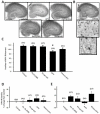Dynorphin up-regulation in the dentate granule cell mossy fiber pathway following chronic inhibition of GluN2B-containing NMDAR is associated with increased CREB (Ser 133) phosphorylation, but is independent of BDNF/TrkB signaling pathways
- PMID: 24769103
- PMCID: PMC4039624
- DOI: 10.1016/j.mcn.2014.04.002
Dynorphin up-regulation in the dentate granule cell mossy fiber pathway following chronic inhibition of GluN2B-containing NMDAR is associated with increased CREB (Ser 133) phosphorylation, but is independent of BDNF/TrkB signaling pathways
Abstract
Emerging evidence suggests that neuronal responses to N-methyl-d-aspartate (NMDAR) activation/inactivation are influenced by subunit composition. For example, activation of synaptic NMDAR (comprised of GluN2A>GluN2B) phosphorylates cAMP-response-element-binding protein (CREB) at Ser 133, induces BDNF expression and promotes neuronal survival. Activation of extrasynaptic NMDAR (comprised of GluN2B>GluN2) dephosphorylates CREB (Ser 133), reduces BDNF expression and triggers neuronal death. These results led us to hypothesize that chronic inhibition of GluN2B-containing NMDAR would increase CREB (Ser 133) phosphorylation, increase BDNF levels and subsequently alter downstream dynorphin (DYN) and neuropeptide Y (NPY) expression. We focused on DYN and NPY because these neuropeptides can decrease excitatory neurotransmission and seizure occurrence and we reported previously that seizure-like events are reduced following chronic treatment with GluN2B antagonists. Consistent with our hypothesis, chronic treatment (17-21days) of hippocampal slice cultures with the GluN2B-selective antagonists ifenprodil or Ro25,6981 increased both CREB (Ser 133) phosphorylation and granule cell mossy fiber pathway DYN expression. Similar treatment with the non-subtype-selective NMDAR antagonists d-APV or memantine had no significant effect on either CREB (Ser 133) phosphorylation or DYN expression. In contrast to our hypothesis, BDNF levels were decreased following chronic treatment with Ro25,6981, but not ifenprodil, d-APV or memantine. Blockade of BDNF actions and TrkB activation did not significantly augment hilar DYN expression in vehicle-treated cultures and had no effect in Ro25,6981 treated cultures. These findings suggest that chronic exposure to GluN2B-selective NMDAR antagonists increased DYN expression through a putatively pCREB-dependent, but BDNF/TrkB-independent mechanism.
Keywords: Hippocampus; Ifenprodil; Memantine; N-methyl-d-aspartate; Neuropeptide Y.
Published by Elsevier Inc.
Figures





Similar articles
-
Synaptic and extrasynaptic plasticity in glutamatergic circuits involving dentate granule cells following chronic N-methyl-D-aspartate receptor inhibition.J Neurophysiol. 2013 Mar;109(6):1535-47. doi: 10.1152/jn.00667.2012. Epub 2012 Dec 19. J Neurophysiol. 2013. PMID: 23255721 Free PMC article.
-
Involvement of the GluN2A and GluN2B subunits in synaptic and extrasynaptic N-methyl-D-aspartate receptor function and neuronal excitotoxicity.J Biol Chem. 2013 Aug 16;288(33):24151-9. doi: 10.1074/jbc.M113.482000. Epub 2013 Jul 9. J Biol Chem. 2013. PMID: 23839940 Free PMC article.
-
Mitigation of augmented extrasynaptic NMDAR signaling and apoptosis in cortico-striatal co-cultures from Huntington's disease mice.Neurobiol Dis. 2012 Oct;48(1):40-51. doi: 10.1016/j.nbd.2012.05.013. Epub 2012 Jun 2. Neurobiol Dis. 2012. PMID: 22668780
-
GluN2B/N-methyl-D-aspartate Receptor Antagonists: Advances in Design, Synthesis, and Pharmacological Evaluation Studies.CNS Neurol Disord Drug Targets. 2021;20(9):822-862. doi: 10.2174/1871527320666210309141627. CNS Neurol Disord Drug Targets. 2021. PMID: 33687902 Review.
-
GluN2B subunit selective N-methyl-D-aspartate receptor ligands: Democratizing recent progress to assist the development of novel neurotherapeutics.Mol Divers. 2024 Jun;28(3):1765-1792. doi: 10.1007/s11030-023-10656-0. Epub 2023 Jun 2. Mol Divers. 2024. PMID: 37266849 Free PMC article. Review.
Cited by
-
The Anticonvulsant Effects of Baldrinal on Pilocarpine-Induced convulsion in Adult Male Mice.Molecules. 2019 Apr 24;24(8):1617. doi: 10.3390/molecules24081617. Molecules. 2019. PMID: 31022879 Free PMC article.
-
Immunological Approaches Towards Cancer and Inflammation: A Cross Talk.Front Immunol. 2018 Mar 20;9:563. doi: 10.3389/fimmu.2018.00563. eCollection 2018. Front Immunol. 2018. PMID: 29662489 Free PMC article. Review.
-
LY395756 promotes NR2B expression via activation of AKT/CREB signaling in the juvenile methylazoxymethanol mice model of schizophrenia.Brain Behav. 2022 Feb;12(2):e2466. doi: 10.1002/brb3.2466. Epub 2022 Jan 13. Brain Behav. 2022. PMID: 35025141 Free PMC article.
-
Kappa opioid receptor signaling in the brain: Circuitry and implications for treatment.Prog Neuropsychopharmacol Biol Psychiatry. 2015 Oct 1;62:51-60. doi: 10.1016/j.pnpbp.2015.01.001. Epub 2015 Jan 12. Prog Neuropsychopharmacol Biol Psychiatry. 2015. PMID: 25592680 Free PMC article. Review.
-
NMDA Receptors and Oxidative Stress Induced by the Major Metabolites Accumulating in HMG Lyase Deficiency Mediate Hypophosphorylation of Cytoskeletal Proteins in Brain From Adolescent Rats: Potential Mechanisms Contributing to the Neuropathology of This Disease.Neurotox Res. 2015 Oct;28(3):239-52. doi: 10.1007/s12640-015-9542-z. Epub 2015 Jul 15. Neurotox Res. 2015. PMID: 26174040
References
-
- Andersson G, Påhlman S, Parrow V, Johansson I, Hammerling U. Activation of the human NPY gene during neuroblastoma cell differentiation: induced transcriptional activities of AP-1 and AP-2. Cell Growth Differ. 1994;5:27–36. - PubMed
-
- Bannister AJ, Kouzarides T. The CBP co-activator is a histone acetyltransferase. Nature. 1996;384:641–643. - PubMed
-
- Baraban SC. Neuropeptide Y and epilepsy: recent progress, prospects and controversies. Neuropeptides. 2004;38:261–265. - PubMed
-
- Barksdale DM, Dong Y, Galdzicki Z, Bausch SB. Differential effects of NR2B selective versus general NMDAR antagonists on CREB phosphorylation and downstream expression of neuropeptides. Soc. Neurosci. Abstr. Program. 2004;49:10.
Publication types
MeSH terms
Substances
Grants and funding
LinkOut - more resources
Full Text Sources
Other Literature Sources
Miscellaneous

